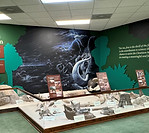Location
109 Central Ave,
Clewiston FL 33440

The Mark & Marisa Renz
Fossil Gallery
The Mark and Marisa Renz Fossil Gallery's collection represents creatures of the Glades from thousands and millions of years ago. The collection consists of fossils of mammoths, mastodons, giant ground sloths, megalodons, saber-tooth cats, a dugong, a giant land tortoise and many others.

The Early Peoples
These prehistoric artifacts were brought to the Lake Okeechobee area by The Belle Glade Culture during the period from about 500 BCE (or BC) - 1700 CE (or AD). The types of artifacts found nclude pottery, spear points/knives, shell sinkers/pendants, bone points, shell adzes, celts, and gouges.


Spanish Treasure
How did gold and silver Spanish treasure make its way to this area to be discovered by local residents hundreds of years later? Learn how it could have made its way here from shipwrecks that occurred off Florida’s coast.


Life on Lake O
Bass, catfish and other fish have been tremendous magnets for sport fishing as well as commercial fishing. The lake ecosystem which includes insects, birds, alligators, and other fauna and flora, plays a huge part in the history of the Glades area.


The Seminole People
The Seminoles have inhabited this area for several hundred years. They are only tribe to have never signed a treaty with the United States Government. Learn about their heritage and the Big Cypress Reservation.


Clewiston Est. 1925 &
Agriculture in Clewiston
The large exhibit gallery is dedicated to sharing the history of Clewiston and its foundations: Lake Okeechobee, the sugar industry, the cattle industry, the soil, and most importantly, the community.

Clewiston played an important role in WWII when the Royal Air Force opened a flight training base at the local airfield. Learn about the RAF's No. 5 British Flight Training School (B.F.T.S.), its Cadets, instructors, and how the community loved and supported them.
Click the title above to read about the life of a #5 BFTS cadet, George Hogarth. Click here to read RAF Over Florida: Memories of World War II Brisitsh Air Cadets by Willard Largent.


